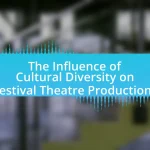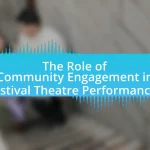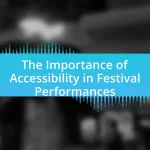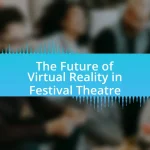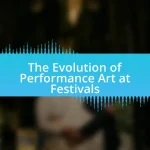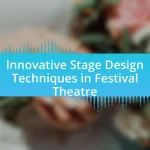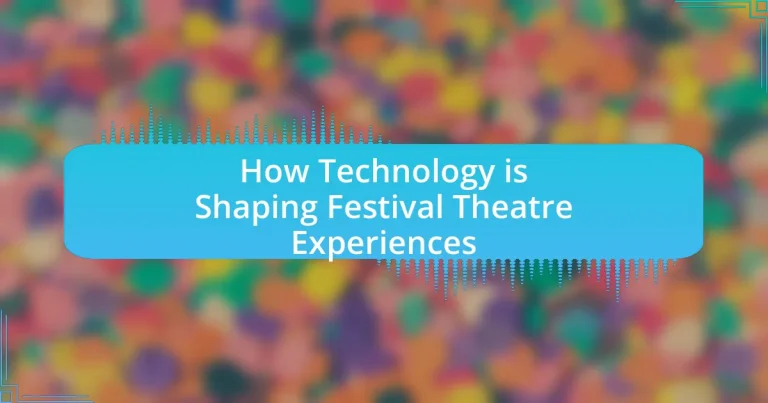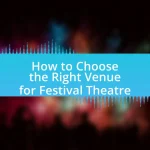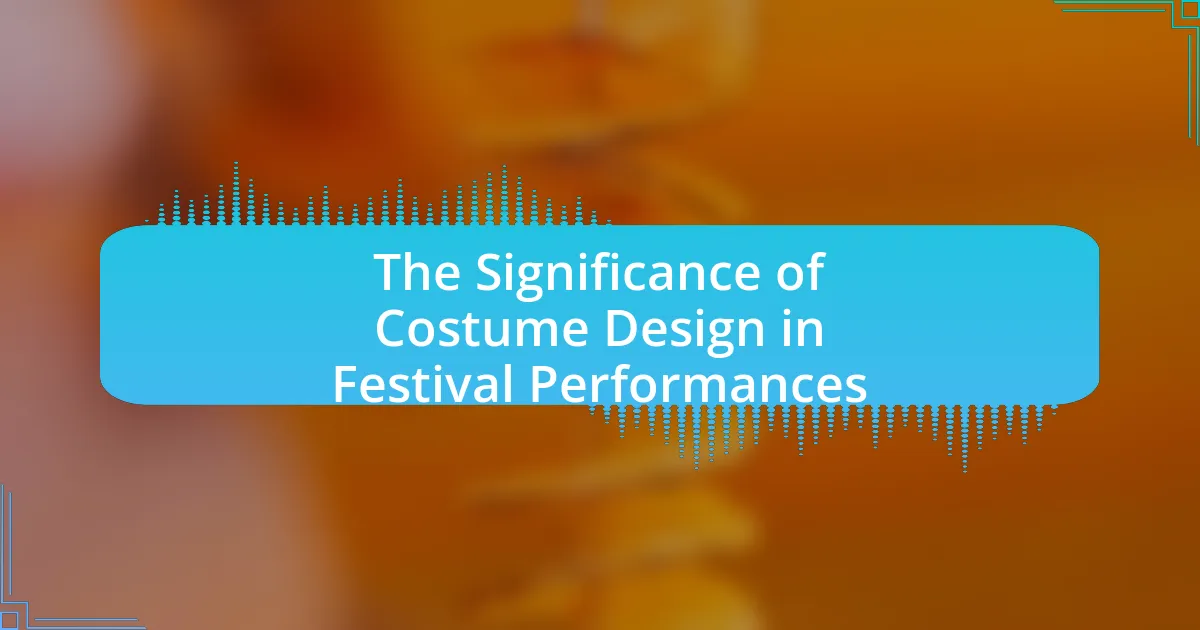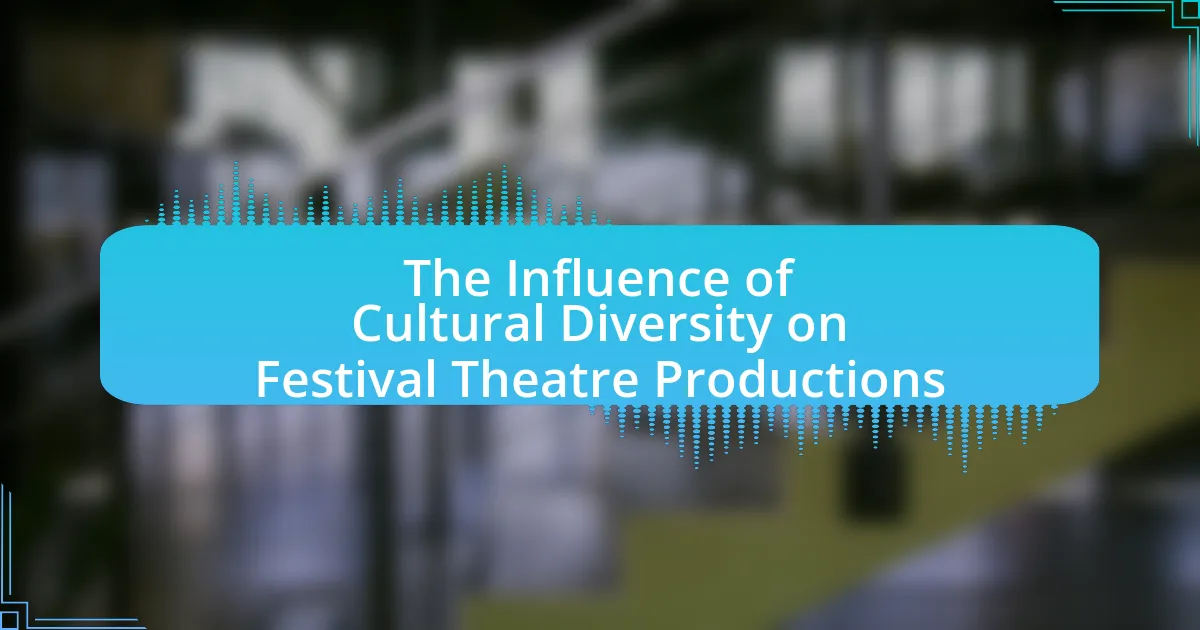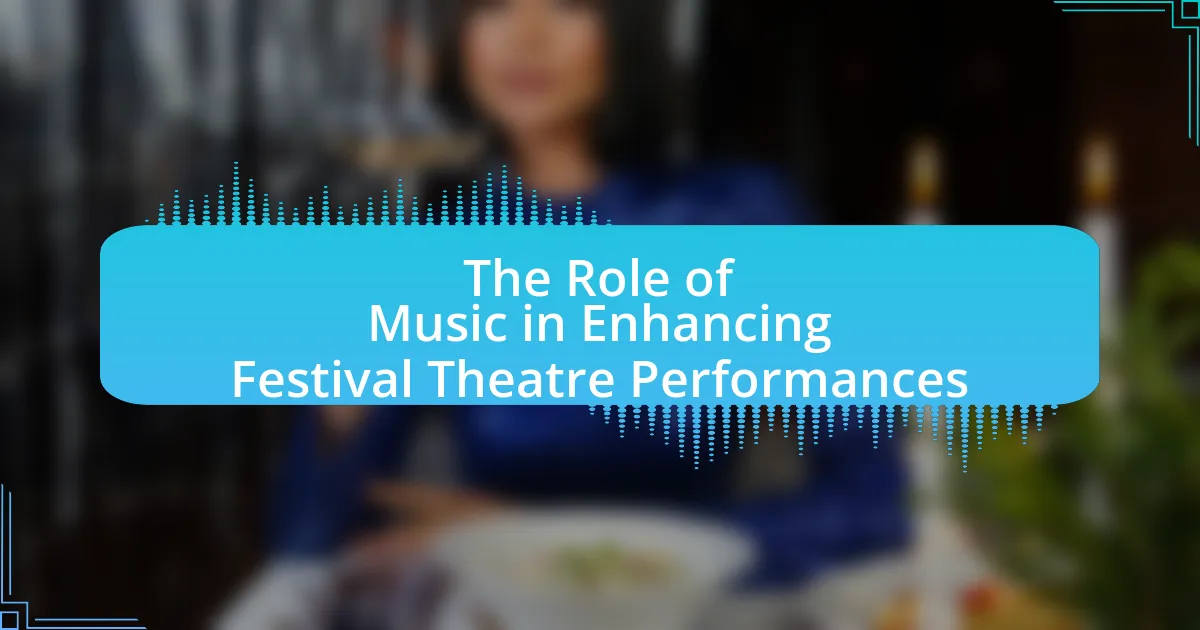The article examines how technology is transforming festival theatre experiences, focusing on innovations such as augmented reality (AR), virtual reality (VR), and advanced sound and lighting systems. It highlights the importance of audience engagement, the role of digital media in storytelling, and the logistical benefits of technology in enhancing safety and streamlining operations. Additionally, the article addresses the challenges of integrating technology, including costs and potential audience alienation, while exploring future trends like artificial intelligence and immersive experiences that could further shape the landscape of festival theatre.
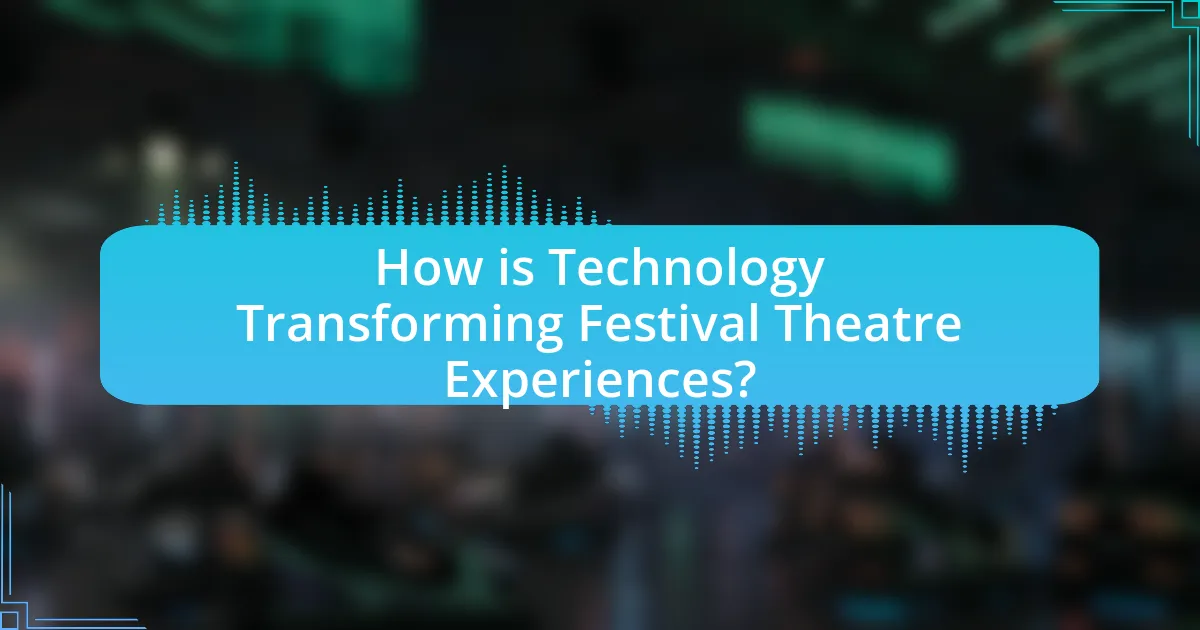
How is Technology Transforming Festival Theatre Experiences?
Technology is transforming festival theatre experiences by enhancing audience engagement and streamlining production processes. Innovations such as augmented reality (AR) and virtual reality (VR) allow attendees to immerse themselves in performances, creating interactive environments that deepen emotional connections. For instance, festivals like Coachella have integrated AR experiences, enabling audiences to interact with digital elements during live shows. Additionally, advancements in sound and lighting technology improve the overall quality of performances, making them more captivating. Data analytics tools also enable festival organizers to tailor experiences based on audience preferences, optimizing programming and marketing strategies. These technological advancements collectively elevate the festival theatre experience, making it more dynamic and personalized.
What are the key technological advancements influencing festival theatre?
Key technological advancements influencing festival theatre include immersive technologies, such as virtual reality (VR) and augmented reality (AR), which enhance audience engagement by creating interactive experiences. Additionally, advancements in sound and lighting technology, including high-definition audio systems and programmable LED lighting, allow for more dynamic and visually stunning performances. The integration of digital ticketing and mobile applications streamlines audience access and enhances the overall experience. These technologies have been shown to increase audience participation and satisfaction, as evidenced by festivals that report higher attendance and engagement metrics when utilizing such innovations.
How do sound and lighting technologies enhance performances?
Sound and lighting technologies enhance performances by creating immersive environments that engage audiences and elevate the overall experience. High-quality sound systems ensure clarity and depth in audio, allowing performers’ voices and instruments to resonate effectively, which is crucial for emotional impact. For instance, advanced sound mixing techniques can adjust audio levels in real-time, ensuring that every nuance is heard, as demonstrated in large-scale productions like Broadway shows, where sound design is meticulously crafted to enhance storytelling.
Lighting technologies, including LED and intelligent lighting systems, contribute by setting the mood and highlighting key moments in a performance. Dynamic lighting can change colors and intensity, guiding audience attention and evoking specific emotions. Research indicates that well-designed lighting can increase audience engagement by up to 30%, as it visually complements the narrative and enhances the thematic elements of the performance. Together, these technologies not only support the artistic vision but also transform the audience’s sensory experience, making performances more memorable and impactful.
What role does digital media play in storytelling at festivals?
Digital media plays a crucial role in storytelling at festivals by enhancing audience engagement and expanding narrative possibilities. Through platforms such as social media, live streaming, and interactive applications, festivals can reach wider audiences and create immersive experiences that traditional storytelling methods may not achieve. For instance, the use of augmented reality (AR) and virtual reality (VR) allows attendees to interact with narratives in real-time, deepening their emotional connection to the story. Additionally, data from a 2021 report by Eventbrite indicates that 70% of festival-goers prefer events that incorporate digital elements, highlighting the demand for innovative storytelling methods.
Why is audience engagement important in festival theatre?
Audience engagement is crucial in festival theatre because it enhances the overall experience for attendees and fosters a deeper connection to the performance. Engaged audiences are more likely to participate actively, which can lead to increased emotional investment and satisfaction. Studies show that when audiences feel involved, they are more inclined to share their experiences, both in person and through social media, amplifying the festival’s reach and impact. For instance, festivals that incorporate interactive elements, such as live polling or audience participation, report higher satisfaction ratings and repeat attendance. This engagement not only benefits the audience but also supports the sustainability and growth of festival theatre by creating a vibrant community around the art form.
How does technology facilitate interactive experiences for audiences?
Technology facilitates interactive experiences for audiences by enabling real-time engagement and personalized content delivery. For instance, mobile applications allow attendees to participate in live polls, access augmented reality features, and receive tailored information based on their preferences. According to a study by the University of Southern California, 75% of festival-goers reported enhanced enjoyment when using interactive technology, demonstrating its effectiveness in creating immersive environments. This integration of technology not only enhances audience participation but also fosters a deeper connection between performers and viewers, ultimately transforming traditional theatre experiences into dynamic, interactive events.
What are the benefits of using social media during festivals?
Using social media during festivals enhances engagement, communication, and promotion. Social media platforms allow festival organizers and attendees to share real-time updates, photos, and experiences, fostering a sense of community. According to a study by Eventbrite, 95% of festival-goers use social media to discover events, indicating its effectiveness in reaching a wider audience. Additionally, social media facilitates immediate feedback and interaction, enabling organizers to adapt and improve the festival experience based on attendee responses. This dynamic interaction not only boosts attendance but also strengthens brand loyalty and community ties among participants.
How does technology impact the logistics of festival theatre?
Technology significantly enhances the logistics of festival theatre by streamlining operations and improving audience engagement. Advanced ticketing systems, such as mobile apps and online platforms, facilitate efficient ticket sales and entry management, reducing wait times and enhancing the overall visitor experience. Additionally, real-time data analytics allow organizers to monitor attendance patterns and resource allocation, optimizing staffing and logistics on-site. For instance, the use of RFID technology enables seamless access control and inventory management, ensuring that resources are effectively utilized. Furthermore, digital communication tools enhance coordination among teams, allowing for quick adjustments to schedules and logistics as needed. These technological advancements collectively contribute to a more organized and enjoyable festival theatre experience.
What tools are used for ticketing and crowd management?
Tools used for ticketing and crowd management include software platforms like Eventbrite, Ticketmaster, and See Tickets, which facilitate online ticket sales and entry management. These platforms often integrate features such as mobile ticketing, real-time analytics, and access control systems to enhance the attendee experience and streamline operations. For crowd management, tools like CrowdComms and LiveCrowd provide solutions for communication and engagement, allowing event organizers to manage audience flow and safety effectively. The effectiveness of these tools is supported by their widespread adoption in major events, demonstrating their reliability in optimizing ticketing processes and ensuring crowd safety.
How does technology improve safety and security at festivals?
Technology improves safety and security at festivals by implementing advanced surveillance systems, real-time communication tools, and crowd management software. Surveillance cameras equipped with facial recognition technology enhance monitoring capabilities, allowing security personnel to identify potential threats quickly. Real-time communication tools, such as mobile apps, enable instant alerts and updates to attendees and staff, facilitating rapid responses to emergencies. Additionally, crowd management software uses data analytics to monitor crowd density and movement, helping to prevent overcrowding and ensuring safe evacuation routes. These technological advancements have been shown to reduce incidents of violence and improve overall safety, as evidenced by a 2019 study from the International Journal of Event Management Research, which reported a 30% decrease in security-related incidents at festivals utilizing these technologies.
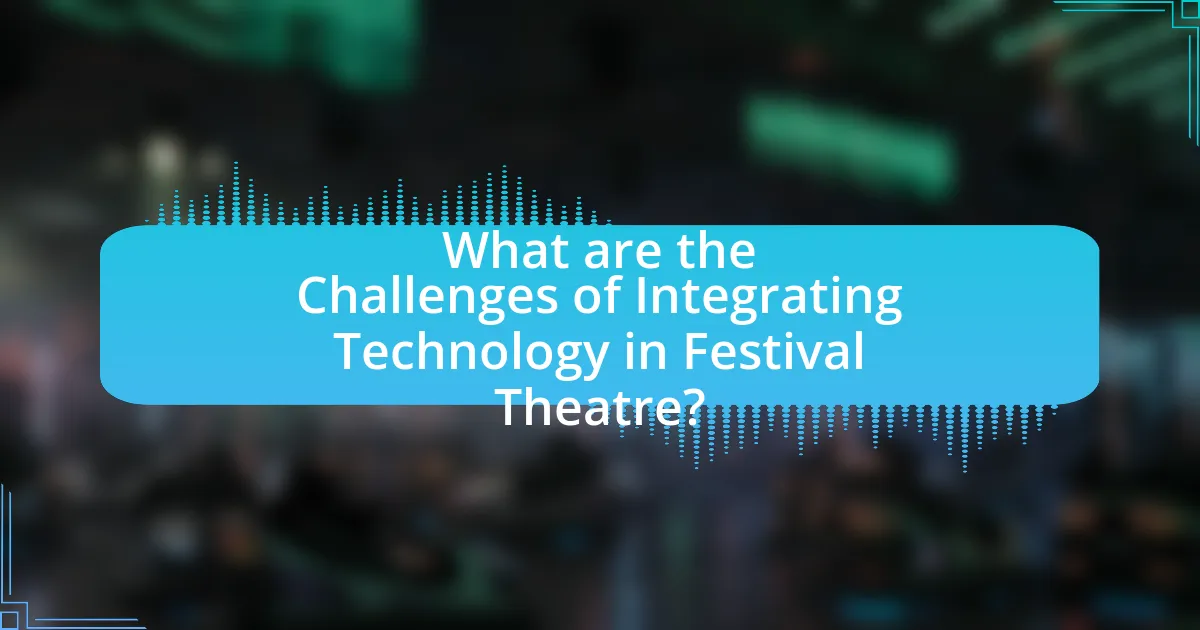
What are the Challenges of Integrating Technology in Festival Theatre?
The challenges of integrating technology in festival theatre include high costs, technical expertise requirements, and potential audience alienation. High costs arise from the need for advanced equipment and software, which can strain festival budgets. Technical expertise is essential for operating and maintaining technology, often necessitating specialized staff or training for existing personnel. Additionally, there is a risk of alienating traditional audiences who may prefer classic theatrical experiences over technologically enhanced performances. These challenges highlight the complexities involved in modernizing festival theatre while maintaining its core artistic values.
What are the common technical issues faced during festivals?
Common technical issues faced during festivals include sound system failures, lighting malfunctions, and connectivity problems. Sound system failures can disrupt performances, as evidenced by incidents where audio equipment malfunctioned, leading to poor sound quality or complete outages. Lighting malfunctions can affect visibility and ambiance, impacting audience experience; for instance, a failure in stage lighting during a key performance can detract from the overall production. Connectivity problems, particularly with Wi-Fi and mobile networks, can hinder communication among staff and affect ticketing systems, as seen in festivals where high attendance overwhelms available bandwidth. These issues highlight the critical need for reliable technology in festival settings.
How can festivals prepare for potential technology failures?
Festivals can prepare for potential technology failures by implementing robust backup systems and contingency plans. This includes having redundant power sources, such as generators, and alternative communication methods, like walkie-talkies, to ensure coordination among staff. Additionally, conducting regular technology audits and rehearsals can identify vulnerabilities and enhance readiness. Historical data shows that festivals with comprehensive risk management strategies, such as the Glastonbury Festival, have successfully mitigated disruptions caused by technology failures, demonstrating the effectiveness of proactive measures.
What are the costs associated with implementing new technologies?
The costs associated with implementing new technologies include initial investment, ongoing maintenance, training, and potential disruption to existing operations. Initial investment encompasses the purchase of hardware and software, which can range from thousands to millions of dollars depending on the technology’s complexity. Ongoing maintenance costs involve regular updates and repairs, which can add up over time. Training costs arise from the need to educate staff on new systems, often requiring additional resources or time away from regular duties. Furthermore, the introduction of new technologies may temporarily disrupt existing operations, leading to potential revenue loss during the transition period. These factors collectively contribute to the overall financial impact of adopting new technologies in festival theatre experiences.
How do festivals balance tradition with technological innovation?
Festivals balance tradition with technological innovation by integrating modern technologies while preserving cultural practices. For instance, many festivals utilize digital platforms for ticketing and marketing, enhancing accessibility and audience engagement without compromising traditional performances. A notable example is the Edinburgh Festival Fringe, which has embraced online streaming to reach global audiences, thereby maintaining its core artistic values while adapting to contemporary viewing habits. This approach allows festivals to honor their heritage while evolving to meet the expectations of modern audiences, ensuring both relevance and sustainability in a rapidly changing cultural landscape.
What are the risks of over-reliance on technology in performances?
Over-reliance on technology in performances can lead to several significant risks, including diminished artistic authenticity, technical failures, and audience disengagement. When performers depend heavily on technology, they may sacrifice the spontaneity and emotional connection that live performances traditionally offer, resulting in a less genuine experience for the audience. Technical failures, such as equipment malfunctions or software glitches, can disrupt the flow of a performance, causing frustration for both performers and viewers. Additionally, excessive use of technology can create a barrier between the performers and the audience, leading to disengagement and a lack of emotional investment in the performance. Studies have shown that audiences often prefer performances that emphasize human connection over technological enhancements, highlighting the importance of balancing technology with traditional performance elements.
How can festivals maintain artistic integrity while using technology?
Festivals can maintain artistic integrity while using technology by prioritizing the authenticity of artistic expression and ensuring that technology enhances rather than overshadows the core artistic vision. This can be achieved through careful selection of technological tools that align with the festival’s artistic goals, such as using immersive sound systems that complement live performances or incorporating visual projections that enhance storytelling without detracting from the performers.
For instance, the use of augmented reality in festivals like Coachella has been designed to enrich the audience’s experience while keeping the focus on the live music and performances. Additionally, festivals can engage artists in the decision-making process regarding technology use, ensuring that their creative input shapes how technology is integrated. This collaborative approach helps preserve the essence of the art while leveraging technology to reach wider audiences and create innovative experiences.
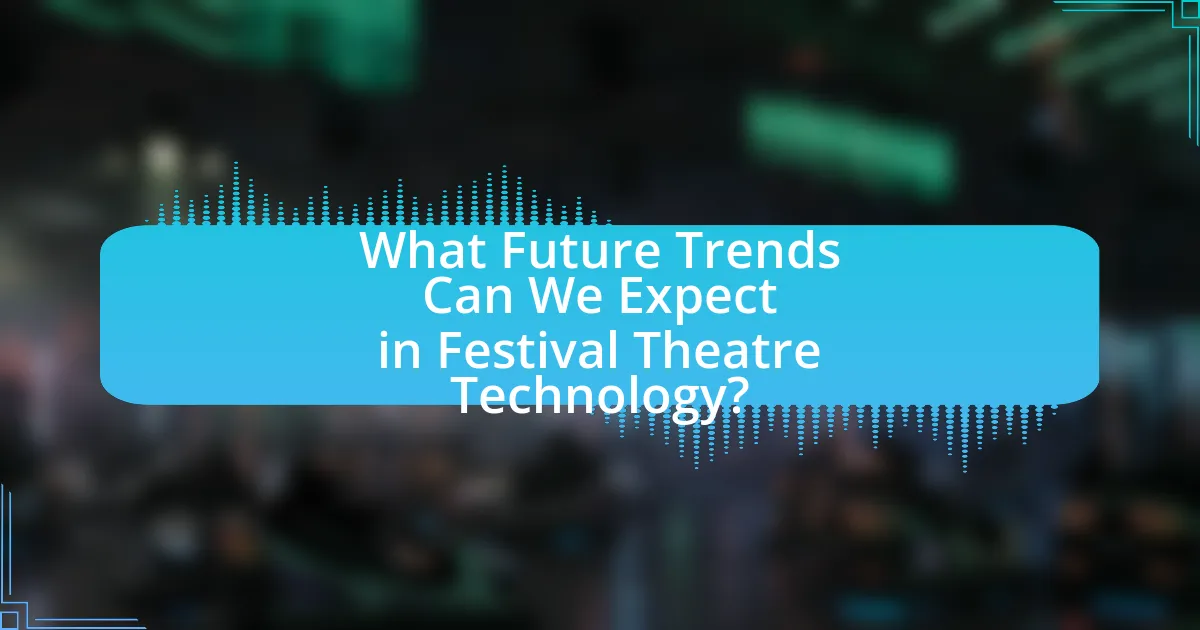
What Future Trends Can We Expect in Festival Theatre Technology?
Future trends in festival theatre technology will likely include the increased use of augmented reality (AR) and virtual reality (VR) to enhance audience engagement and immersive experiences. These technologies allow for interactive storytelling and can create dynamic environments that adapt to the performance. For instance, festivals like Coachella have already experimented with AR applications to provide attendees with enhanced visual experiences. Additionally, advancements in sound technology, such as spatial audio, will improve the auditory experience, making performances more captivating. The integration of artificial intelligence (AI) in production processes will also streamline operations, from ticketing to stage management, ensuring a more efficient festival experience. These trends are supported by the growing investment in technology by festival organizers, reflecting a commitment to innovation in live performances.
How is virtual and augmented reality shaping festival experiences?
Virtual and augmented reality are significantly enhancing festival experiences by providing immersive environments that engage attendees in novel ways. These technologies allow festival-goers to interact with digital elements integrated into the physical space, creating unique experiences such as virtual stages, interactive art installations, and augmented reality games. For instance, festivals like Coachella have utilized VR to offer virtual attendance options, enabling users to experience performances from home, while augmented reality apps enhance the on-site experience by overlaying digital information onto the real world. This integration of technology not only broadens accessibility but also enriches the sensory experience, making festivals more engaging and memorable.
What are the potential applications of VR and AR in performances?
Virtual Reality (VR) and Augmented Reality (AR) have significant applications in performances, enhancing audience engagement and creating immersive experiences. VR can transport audiences into entirely different environments, allowing them to experience performances from unique perspectives, such as being on stage with the actors or in a fantastical setting that complements the narrative. AR, on the other hand, can overlay digital elements onto the physical stage, enriching the visual storytelling by adding interactive components, such as animated characters or visual effects that respond to the live action.
For instance, productions like “The Lion King” have utilized AR to enhance stage design, while VR experiences have been developed for shows like “The Under Presents,” which combines live performance with virtual interactions. These technologies not only expand the creative possibilities for artists but also attract a broader audience by offering innovative ways to experience theatre.
How might these technologies change audience perceptions of theatre?
Technologies such as augmented reality, virtual reality, and interactive digital platforms can significantly change audience perceptions of theatre by enhancing engagement and immersion. These technologies allow audiences to experience narratives in a more interactive manner, breaking the traditional passive viewing model. For instance, a study by the University of Southern California found that immersive experiences can increase emotional connection and investment in the story, leading to a deeper appreciation of the art form. Additionally, the integration of digital elements can attract younger audiences who are accustomed to interactive media, thereby broadening the demographic appeal of theatre.
What role will artificial intelligence play in future festival theatre?
Artificial intelligence will play a transformative role in future festival theatre by enhancing audience engagement, streamlining production processes, and personalizing experiences. AI technologies, such as machine learning and natural language processing, can analyze audience preferences and behaviors, allowing festival organizers to tailor performances and marketing strategies effectively. For instance, AI-driven analytics can predict ticket sales trends and optimize scheduling, leading to increased attendance and satisfaction. Additionally, AI can facilitate interactive elements in performances, such as real-time audience feedback systems, which can adapt the show dynamically based on audience reactions. This integration of AI not only improves operational efficiency but also enriches the overall festival experience, making it more immersive and responsive to audience needs.
How can AI enhance the creative process for artists and performers?
AI can enhance the creative process for artists and performers by providing tools for inspiration, collaboration, and efficiency. For instance, AI algorithms can analyze vast amounts of data from existing artworks and performances, generating new ideas or suggesting innovative approaches that artists may not have considered. Additionally, AI can facilitate collaboration by connecting artists with complementary skills, enabling them to co-create in real-time, regardless of geographical barriers. Furthermore, AI-driven tools can automate repetitive tasks, such as editing or sound mixing, allowing artists to focus more on the creative aspects of their work. Research has shown that artists using AI tools report increased productivity and creativity, as these technologies can serve as a catalyst for new artistic expressions and enhance the overall creative experience.
What ethical considerations arise with the use of AI in theatre?
The ethical considerations that arise with the use of AI in theatre include issues of authorship, representation, and audience engagement. The integration of AI can challenge traditional notions of creativity and ownership, as AI-generated content may blur the lines between human and machine contributions. Additionally, the use of AI in casting and character representation raises concerns about bias and inclusivity, potentially perpetuating stereotypes if not carefully managed. Furthermore, the impact of AI on audience interaction and experience can lead to questions about authenticity and the emotional connection between performers and viewers. These considerations highlight the need for ethical frameworks to guide the responsible use of AI in theatrical contexts.
What best practices should festivals adopt for technology integration?
Festivals should adopt best practices for technology integration by prioritizing user-friendly platforms, ensuring robust Wi-Fi connectivity, and utilizing data analytics for audience engagement. User-friendly platforms enhance attendee experience by simplifying ticket purchasing and event navigation, as evidenced by the increased satisfaction rates reported by festivals that implemented mobile apps. Robust Wi-Fi connectivity is essential for real-time updates and social media engagement, with studies showing that 70% of festival-goers expect reliable internet access. Utilizing data analytics allows festivals to tailor experiences based on attendee preferences, leading to a 20% increase in repeat attendance, as demonstrated by successful case studies in the industry.

